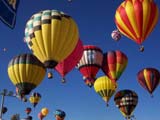 The
Albuquerque Balloon Festival was MUCH more spectacular than we ever imagined.
The Festival (now called a Fiesta) has been "on our list"
for years. We were lucky enough this year to not only attend, but to
participate. Between the two of us, we took 500 pictures; more than
we've taken at any of the fantastic places that we visited to date. Thank
God for DIGITAL cameras!
The
Albuquerque Balloon Festival was MUCH more spectacular than we ever imagined.
The Festival (now called a Fiesta) has been "on our list"
for years. We were lucky enough this year to not only attend, but to
participate. Between the two of us, we took 500 pictures; more than
we've taken at any of the fantastic places that we visited to date. Thank
God for DIGITAL cameras!
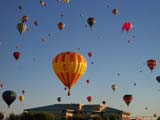 We
belong to an RV organization called Escapees, and to an unstructured
subgroup within it called the Boomers. The Boomers are a (comparatively)
younger group of RV'rs that are activity oriented. One of the Boomer couples
(Bill & Darlene) owns a balloon named $hebrokeu$.
Another Boomer couple (Craig & Terrie) organized a get-together (called
a Boomer-rang) at the Fiesta (in this case, a Ballooner-rang).
We had about 8 rigs in the core group with others coming and going during
the 10 day event. We arrived in Albuquerque a day early (September 30th) and
were assigned a terrific campspot with an unobstructed view directly under
the takeoff path. The balloons passed by us
flying so low that we had to lower our TV antennas.
We
belong to an RV organization called Escapees, and to an unstructured
subgroup within it called the Boomers. The Boomers are a (comparatively)
younger group of RV'rs that are activity oriented. One of the Boomer couples
(Bill & Darlene) owns a balloon named $hebrokeu$.
Another Boomer couple (Craig & Terrie) organized a get-together (called
a Boomer-rang) at the Fiesta (in this case, a Ballooner-rang).
We had about 8 rigs in the core group with others coming and going during
the 10 day event. We arrived in Albuquerque a day early (September 30th) and
were assigned a terrific campspot with an unobstructed view directly under
the takeoff path. The balloons passed by us
flying so low that we had to lower our TV antennas.
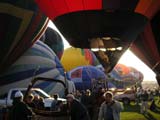 Having
"our own" balloon allowed us to be part of the action instead of
just being spectators. Ballooning is not a solitary sport. There are arguments
about how many crew members it takes to manage a takeoff and landing. We generally
had about 20 people in 2 chase vehicles, and each of us was "involved'.
Our balloon pilot, driving chase vehicle #1, would leave for the field every
morning at 5:45 AM to attend the pilot briefing and find out what the weather
had in store. The rest of the crew would pile into BobnPaty's truck (chase
vehicle #2) at 6:30AM and head for the field to begin the setup process. As
we were climbing into the truck, we could see the Dawn
Patrol floating by in the pre-dawn darkness.
Having
"our own" balloon allowed us to be part of the action instead of
just being spectators. Ballooning is not a solitary sport. There are arguments
about how many crew members it takes to manage a takeoff and landing. We generally
had about 20 people in 2 chase vehicles, and each of us was "involved'.
Our balloon pilot, driving chase vehicle #1, would leave for the field every
morning at 5:45 AM to attend the pilot briefing and find out what the weather
had in store. The rest of the crew would pile into BobnPaty's truck (chase
vehicle #2) at 6:30AM and head for the field to begin the setup process. As
we were climbing into the truck, we could see the Dawn
Patrol floating by in the pre-dawn darkness.
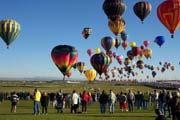 Bill's
objective was to give each of his crew members a chance
to fly. He tried to make 2 or 3 hops every day; stopping only long enough
to change passengers. His balloon carried 40 gallons of propane and two passengers.
By the time he landed for the second or third time, his propane supply would
be nearly exhausted. Note: With the high price of fuel these days, you might
be wondering who was paying for the propane. Fortunately, the Fiesta does.
The balloons are the "entertainment" and the Fiesta treats them
accordingly.
Bill's
objective was to give each of his crew members a chance
to fly. He tried to make 2 or 3 hops every day; stopping only long enough
to change passengers. His balloon carried 40 gallons of propane and two passengers.
By the time he landed for the second or third time, his propane supply would
be nearly exhausted. Note: With the high price of fuel these days, you might
be wondering who was paying for the propane. Fortunately, the Fiesta does.
The balloons are the "entertainment" and the Fiesta treats them
accordingly.
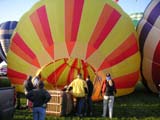 Setting
up the balloon required gloves and instruction.
Each morning, our job as crew would entail taking the (500 pound) basket off
Bill's truck and erecting the framework that
holds the burners. Next we would take down the bag containing the envelope
(balloon) and walk it out to its full length.
After making sure that the correct load straps were on top, we connected
the envelope to the basket with 4 locking carabiners. Then two of us would
hold open the mouth of the envelope while another would start a gasoline powered
fan and direct the airflow through the mouth to inflate the balloon. This
was a COLD job in the early morning at Albuquerque's
elevation of 5,000 feet! Once the envelope had filled, the pilot would get
into the basket (which was still laying on its side at this point) and press
the burner triggers to shoot several blasts to heat the air in the envelope
and make it stand up (lifting the basket into an upright position). He would
then perform a series of preflight checks which Bill called his "magic
pilot shit". The passengers would then climb into the basket and the
pilot would shoot (a lot) more hot air into the envelope while a bunch of
us were acting as ballast (called "weight on"), holding it
down and keeping it from drifting. Soon the balloon would rise and the
"chase" was on.
Setting
up the balloon required gloves and instruction.
Each morning, our job as crew would entail taking the (500 pound) basket off
Bill's truck and erecting the framework that
holds the burners. Next we would take down the bag containing the envelope
(balloon) and walk it out to its full length.
After making sure that the correct load straps were on top, we connected
the envelope to the basket with 4 locking carabiners. Then two of us would
hold open the mouth of the envelope while another would start a gasoline powered
fan and direct the airflow through the mouth to inflate the balloon. This
was a COLD job in the early morning at Albuquerque's
elevation of 5,000 feet! Once the envelope had filled, the pilot would get
into the basket (which was still laying on its side at this point) and press
the burner triggers to shoot several blasts to heat the air in the envelope
and make it stand up (lifting the basket into an upright position). He would
then perform a series of preflight checks which Bill called his "magic
pilot shit". The passengers would then climb into the basket and the
pilot would shoot (a lot) more hot air into the envelope while a bunch of
us were acting as ballast (called "weight on"), holding it
down and keeping it from drifting. Soon the balloon would rise and the
"chase" was on.
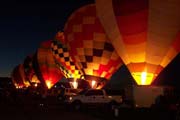 Hot
air balloons have no steering; the only directional control they have is up
and down; the pilot doesn't know where he's going to land until he sees where
the wind is taking him. That's why a chase vehicle (or two) is necessary.
The unique weather pattern in Albuquerque (called the "box") makes
it an ideal spot for ballooning. At ground level, the winds generally flow
down the Rio Grande valley from north to south, while 1,000 feet higher the
winds reverse direction and flow from south to north. In between the air is
(virtually) still, allowing balloons to hover virtually motionless for long
periods of time.
Hot
air balloons have no steering; the only directional control they have is up
and down; the pilot doesn't know where he's going to land until he sees where
the wind is taking him. That's why a chase vehicle (or two) is necessary.
The unique weather pattern in Albuquerque (called the "box") makes
it an ideal spot for ballooning. At ground level, the winds generally flow
down the Rio Grande valley from north to south, while 1,000 feet higher the
winds reverse direction and flow from south to north. In between the air is
(virtually) still, allowing balloons to hover virtually motionless for long
periods of time.
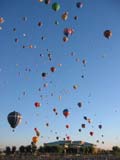 Each
of our two chase vehicles had a driver and a navigator. The navigator's tools
were a detailed road map and an FRS radio. The pilot would watch where the
winds were taking him and look for an empty spot to put her down. Meanwhile,
the two chase vehicles were trying to guess which landing area he was heading
for and were competing to see who would reach the landing spot first. By tradition,
the next person to fly comes from the first chase vehicle to arrive. Hopefully
at least one of the chase vehicles would be there waiting when the balloon
touches down. If the winds are at all strong, the balloon is going to be dragged
along the ground until people grab it and apply weight-on. Everyone
helps with weight-on; especially if the chase crew doesn't get there before
the balloon lands (which is the usual situation). On Patty's flight, a bunch
of strangers ran up and grabbed her balloon. She took a picture of one of
the young kids happily acting as ballast.
Each
of our two chase vehicles had a driver and a navigator. The navigator's tools
were a detailed road map and an FRS radio. The pilot would watch where the
winds were taking him and look for an empty spot to put her down. Meanwhile,
the two chase vehicles were trying to guess which landing area he was heading
for and were competing to see who would reach the landing spot first. By tradition,
the next person to fly comes from the first chase vehicle to arrive. Hopefully
at least one of the chase vehicles would be there waiting when the balloon
touches down. If the winds are at all strong, the balloon is going to be dragged
along the ground until people grab it and apply weight-on. Everyone
helps with weight-on; especially if the chase crew doesn't get there before
the balloon lands (which is the usual situation). On Patty's flight, a bunch
of strangers ran up and grabbed her balloon. She took a picture of one of
the young kids happily acting as ballast.
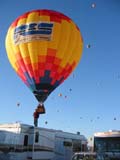 We
weren't crewing on our last day, and Bob saw $hebrokeu$ floating low
over our RV. He was standing there ready to take a picture of it dropping
down for a landing (and hitting the antenna on a nearby RV by the way) when
Bill started yelling "NEED HELP". Bob, along with everyone else
within earshot, started sprinting along the balloon's descent path to grab
on and stop him. Another time, our chase crew was driving around waiting for
Bill to land when we saw a balloon get hung up in a tree. Everybody but the
driver piled out of our truck and ran to help (the driver has to be ready
to get his truck out of the way in a hurry if another balloon is coming down).
Like we said, it's really fun being "part of the action"!
We
weren't crewing on our last day, and Bob saw $hebrokeu$ floating low
over our RV. He was standing there ready to take a picture of it dropping
down for a landing (and hitting the antenna on a nearby RV by the way) when
Bill started yelling "NEED HELP". Bob, along with everyone else
within earshot, started sprinting along the balloon's descent path to grab
on and stop him. Another time, our chase crew was driving around waiting for
Bill to land when we saw a balloon get hung up in a tree. Everybody but the
driver piled out of our truck and ran to help (the driver has to be ready
to get his truck out of the way in a hurry if another balloon is coming down).
Like we said, it's really fun being "part of the action"!
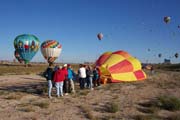 After
the last hop, our crew's job was to take down the balloon and pack it away.
After disconnecting the basket and pulling the balloon out straight, our job
was to squeeze the air out of it before neatly
folding the envelope into its sack. Not an easy job! Fortunately all of the
balloon owners have lift gates installed on their pickup trucks. I'd hate
to think about lifting that heavy basket into the truck bed.
After
the last hop, our crew's job was to take down the balloon and pack it away.
After disconnecting the basket and pulling the balloon out straight, our job
was to squeeze the air out of it before neatly
folding the envelope into its sack. Not an easy job! Fortunately all of the
balloon owners have lift gates installed on their pickup trucks. I'd hate
to think about lifting that heavy basket into the truck bed.
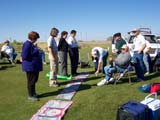 The
next order of business was returning to the field for a ceremony
inducting first-time flyers into the elite club of balloonists. Bill would
break out a "prayer rug" and recite the balloonist's creed before
pouring the Champaign. The initiates had to kneel on the prayer rug and pick
up the plastic glass full of Champaign with their teeth, drinking it down
with no hands. Next came the "pinning"
where Bill or Darlene would pin a balloon emblem in an area of their choosing.
When the ceremony was finished, the FIRST happy hour would begin (at 10 o'clock
in the morning!). An hour or so later, we'd head back to our rigs for some
rest (or a bike ride) before the NEXT happy hour
started at 4 PM. The second happy hour was designated as a "mandatory"
meeting to disseminate plans for the next day.
The
next order of business was returning to the field for a ceremony
inducting first-time flyers into the elite club of balloonists. Bill would
break out a "prayer rug" and recite the balloonist's creed before
pouring the Champaign. The initiates had to kneel on the prayer rug and pick
up the plastic glass full of Champaign with their teeth, drinking it down
with no hands. Next came the "pinning"
where Bill or Darlene would pin a balloon emblem in an area of their choosing.
When the ceremony was finished, the FIRST happy hour would begin (at 10 o'clock
in the morning!). An hour or so later, we'd head back to our rigs for some
rest (or a bike ride) before the NEXT happy hour
started at 4 PM. The second happy hour was designated as a "mandatory"
meeting to disseminate plans for the next day.
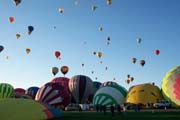 The
activity on the launch field was extremely well organized. A balloon miester
officiates at the pilot briefing and determines if the weather conditions
are right (we didn't fly on 2 of the 10 days). Officials (called zebras) roam
the field dressed like football referees in outrageous
costumes. Their job is to tell the balloons when to begin inflating and
when to launch. It is really beautiful to see a dozen huge balloons side
by side, all at the same stage of setup
or inflation. The launch field is huge, with at least 30 rows and 11 station
in each row; we were assigned launch station J-11. There were two launch waves
with about 350 balloons going up in each wave. The balloon we were supporting,
$hebrokeu$, always launched in the first wave. The sight of so many
colorful balloons lifting off at the same time is truly awe inspiring, particularly
when viewed from inside one of the ascending balloons!
The
activity on the launch field was extremely well organized. A balloon miester
officiates at the pilot briefing and determines if the weather conditions
are right (we didn't fly on 2 of the 10 days). Officials (called zebras) roam
the field dressed like football referees in outrageous
costumes. Their job is to tell the balloons when to begin inflating and
when to launch. It is really beautiful to see a dozen huge balloons side
by side, all at the same stage of setup
or inflation. The launch field is huge, with at least 30 rows and 11 station
in each row; we were assigned launch station J-11. There were two launch waves
with about 350 balloons going up in each wave. The balloon we were supporting,
$hebrokeu$, always launched in the first wave. The sight of so many
colorful balloons lifting off at the same time is truly awe inspiring, particularly
when viewed from inside one of the ascending balloons!
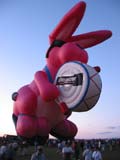 Not
all balloons are built in the same shape. The most unique ones are classified
as Special Shapes and get special
launch considerations. Walking among them as they're inflating is an experience
not to be missed. Another beautiful aspect of the Fiesta is the Balloon
Glow (called a Glowdio). On assigned
nights, a whole field full of balloons are tethered to chase truck bumpers
and inflated with just enough hot air applied to keep them standing straight
up. On the command of the balloon miester, every balloon activates its burners
to make the envelope glow. Whether you're watching it from right up close
or far back, the view is spectacular!
Not
all balloons are built in the same shape. The most unique ones are classified
as Special Shapes and get special
launch considerations. Walking among them as they're inflating is an experience
not to be missed. Another beautiful aspect of the Fiesta is the Balloon
Glow (called a Glowdio). On assigned
nights, a whole field full of balloons are tethered to chase truck bumpers
and inflated with just enough hot air applied to keep them standing straight
up. On the command of the balloon miester, every balloon activates its burners
to make the envelope glow. Whether you're watching it from right up close
or far back, the view is spectacular!
We understand that over 1 million people come to the Balloon Fiesta. We are so lucky to have been a part of it.